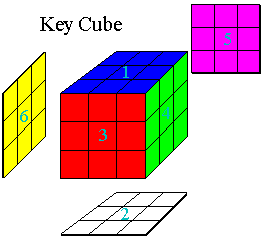Legend: Key to Symbols for the Moves

The figures in this document represent a sample cube. You should match as many colors on your cube as possible to the figures, then make mental notes about which colors correspond between your cube and the figures. In addition, the middle-center pieces are numbered for reference such that 1 and 2 are opposite each other and 3, 4, 5, and 6 go around the cube in a circle. Finally, the diagrams show all six sides of the cube by pretending that mirrors are being held up so that you may see the "hidden" sides.
The directions for what parts of the cube to turn and when are given in a code that is relative to the current positioning of the cube. Each side or slice descriptor refers to a side with respect to the figure the move is referenced to. This means that the front side can be a different color, depending on the diagram being used. The code is easy to follow and instructive diagrams are included for each of the moves.
The Letters:
The side descriptors are:
- U for the top (Upper) side
- L for the left hand side
- F for the front side
The slice descriptors are:
- H for the horizontal slice between the top and bottom sides)
- V for the vertical slice (between the left and right sides).
Although the directions are relative to the current positioning of the cube, the numbers assigned to each side always stay with the same color/side they were originally assigned.
There are no symbols listed for the bottom, right, and back because these directions do not require them.
The Numbers:
The numbers tell you which direction to rotate a given side or slice and how many times to rotate it: 1 for one quarter turn clockwise, -1 for one quarter turn counterclockwise, and 2 for two quarter turns (half way around).
- For example, U F2 L-1 means to rotate the upper side clockwise one quarter turn, the front side clockwise twice (half way around), and the left side counterclockwise one quarter turn. Look directly at the specified side indicated to determine which direction is clockwise or counterclockwise.
- For the vertical slice, V, look at the cube through the right side to determine the clockwise direction.
- For the horizontal slice, H, look at the cube through the top side to determine the clockwise direction.
In the figures, any gray pieces represent pieces that don't matter and can be any color. To increase clarity, the figures do, at times, have extra colored pieces to represent an example of the situation being described; keep this in mind when comparing the cubes shown to your cube. Wherever there are numbers on the pieces in the figures, those colors must match yours exactly.